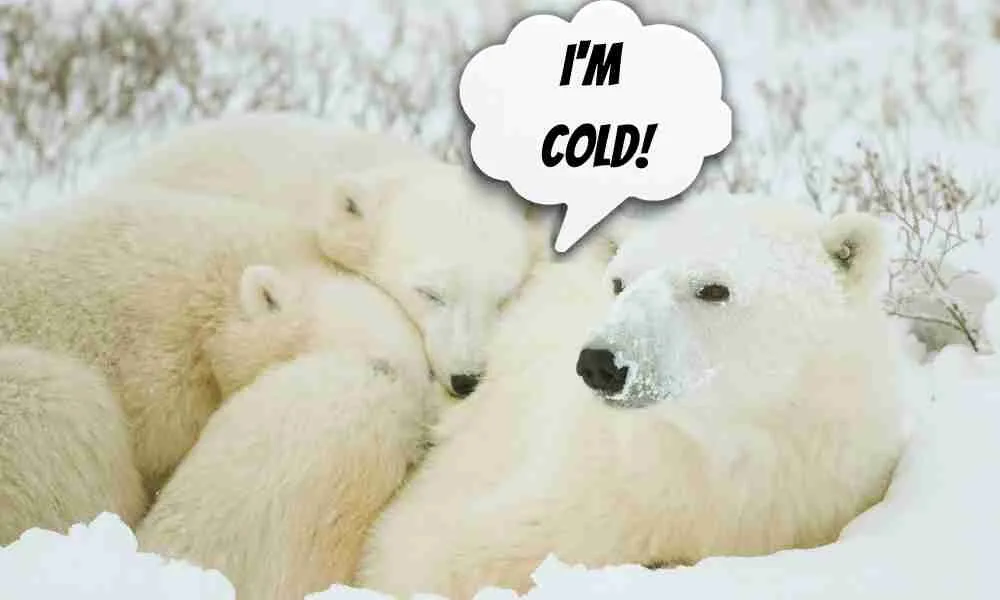After watching the Clan of the North documentary, you may wonder how polar bears survive in the cold. The cold in these areas may seem dangerous to any living thing.
However, can the freezing temperature kill polar bears?
No, polar bears cannot freeze to death. These bears have the adaptation that allows them to survive in many extreme cold temperatures.
The Physical natural characteristics of polar bears aid in their survival. Other various facts explain the relationship between polar bears and the cold.
So how cold can polar bears survive? Continue reading below to find out!
How Cold Can Polar Bears Survive?
Polar bears can survive in cold temperatures of up to -50°C (-58°F). Polar bears can live well in the coldest arctic winter temperatures.
In the polar bear’s natural habitat, there are situations where the temperatures can drop so much. On some occasions, the temperature drops up to -60 °C (-76°F).
Sometimes this temperature goes even lower, but the polar bears still manage to live.
How Does a Polar Bear’s Skin Help It Survive in Winter?
The skin of the polar bear has a double fur coat. This fur coat is among the top things that help polar bears to survive in the freezing Arctic.
Two kinds of coats make up a polar bear’s hide. They include the inner coat and the outer one.
The outer coat is usually thicker and more dense. Additionally, the coat in this outer section is also rough to prevent cold from penetrating.
Furthermore, the inner coat is less dense than the outer one but still has an important role in filtering the cold. While still on the skin, there is a thick layer of fat.
And this fat is on the underside of the skin. Fats play a huge role in preventing the arctic cold from getting inside the body.
Complex nature of the fur above the skin and the fat below plays important roles in the Arctic. Above all, the skin is the first defense of polar bears against the cold.
What’s The Hottest Temperature Polar Bears Can Take?

Polar bears live in the cold but can survive in hot environments of up to 50°C (122°F). Too much heat for polar bears is dangerous and can lead to health problems.
Any temperature above 50°C (122°F) is dangerous to these arctic mammals. When polar bears experience too much heat, they begin getting several issues.
Some of the common problems include
- Dehydration
- Heat stress
- Weakness
- Loss of appetite
It is difficult for polar bears to survive in temperatures above 50°C (122°F) for several reasons. One of the main reasons is that polar bears have thick fur.
Their thick fur is an adaptation for survival in cold climates since it helps them retain internal heat. Moreover, the heat inside can accumulate in hot places, making the polar bear uncomfortable.
Why Do Polar Bears Not Get Hypothermia?
Polar bears cannot suffer from hypothermia due to the presence of a thick layer of fat that protects them. Apart from the layer of fat, several more adaptations protect polar bears from hypothermia.
Below are some of the main protective mechanisms of polar bears from hypothermia:
- Hollow hair
- Small extremities
- Blood flow reduction to the extremities
Hollow Hair
The hollow hairs in polar bears are among the top adaptations for hypothermia defense. These hairs can trap a certain amount of air. The air in storage works to provide additional heat to the polar bear.
In other words, the hollow hair is additional insulation for the polar bear.
Small Extremities

Polar bears are relatively huge. However, they have very small ears, limbs, and tails. These parts are very small and not proportional to the large body.
Despite that, the small extremities play an important role in preventing hypothermia.
The limbs and the other body parts are small, thus preventing heat loss. Once the polar bear can retain maximum heat, it may be difficult for hypothermia to occur.
Blood Flow Reduction to the Extremities
Most body parts, such as limbs, noses, and paws, are already small. But in freezing temperatures, the polar bear’s body can reduce blood supply to these body parts.
As a result, the polar bear gets to maximize the heat in the body. Therefore, hypothermia cannot occur in polar bears.
How Do Polar Bears Keep From Freezing?
Polar bears can keep themselves from freezing by performing several activities. For instance, polar bears can:
- Huddle
- Shiver
- Reduce activities
- Look for shelter
Huddle
Huddling is one of the most common things polar bears do to keep themselves from freezing. In extremely cold temperatures, polar bears usually get together in several groups.
In this case, the polar bears can remain warm by sharing their body heat.
Shiver
Another thing that polar bears do during extreme cold is shivering.
Shivering may work as an involuntary activity for polar bears. However, it is a function that still keeps these bear species from freezing.
Reduce Activities

Polar bears can cut down their level of daily activities to remain warm. However, this can only take place in extremely cold temperatures.
In this case, the polar bears hibernate for long hours till the cold passes.
Look for shelter
In extremely cold temperatures, polar bears can seek shelter to avoid the wind. Most of the time, these bears can stay behind rocks or snowdrifts.
Do Polar Bears Ever Get Cold?
Yes, polar bears can get cold the same way it happens to other animals in the Arctic. However, polar bears have special features and mechanisms which help them survive the sub-zero temperatures.
These survival features allow them to adapt properly to the cold.
Related Questions:
Can Polar Bears Live Without Ice?
No, polar bears need ice for survival. Ice helps polar bears perform most of their survival activities, such as hunting.
Without ice, polar bears will die since it is important for their everyday survival.
Are Polar Bears Dying Because of Ice Melting?
Yes, polar bears are dying as ice keeps melting in their regions. The loss of sea ice is making polar bears vulnerable.
In this case, polar bears cannot hunt, making them starve. And if they can’t find food elsewhere, they eventually die of starvation.
Final Thoughts
In summary, polar bears cannot freeze to death. Several adaptability factors, like thick fur and the fat under the skin, allow this animal to adapt.
What’s more, polar bears prove to have the ability to survive in environments that other types of bears can’t.
Differences between polar bears and other bears make them unique in surviving in the Arctic. Giant Pandas, in particular, live in an environment that gets pretty cold in winter.
What’s interesting is that they survive chilly conditions too. So does this make them similar to polar bears?
Here are some similarities and differences between polar bears and giant pandas.

